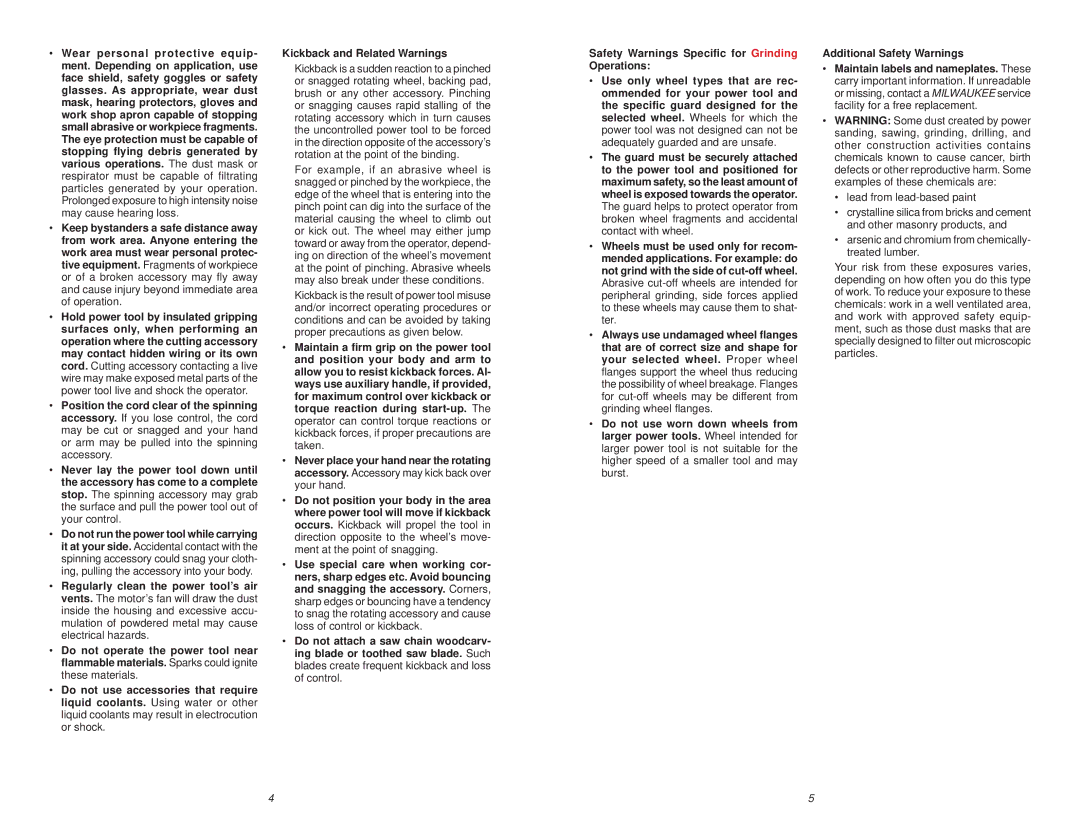•Wear personal protective equip- ment. Depending on application, use face shield, safety goggles or safety glasses. As appropriate, wear dust mask, hearing protectors, gloves and work shop apron capable of stopping small abrasive or workpiece fragments. The eye protection must be capable of stopping flying debris generated by various operations. The dust mask or respirator must be capable of filtrating particles generated by your operation. Prolonged exposure to high intensity noise may cause hearing loss.
•Keep bystanders a safe distance away from work area. Anyone entering the work area must wear personal protec- tive equipment. Fragments of workpiece or of a broken accessory may fly away and cause injury beyond immediate area of operation.
•Hold power tool by insulated gripping surfaces only, when performing an operation where the cutting accessory may contact hidden wiring or its own cord. Cutting accessory contacting a live wire may make exposed metal parts of the power tool live and shock the operator.
•Position the cord clear of the spinning accessory. If you lose control, the cord may be cut or snagged and your hand or arm may be pulled into the spinning accessory.
•Never lay the power tool down until the accessory has come to a complete stop. The spinning accessory may grab the surface and pull the power tool out of your control.
•Do not run the power tool while carrying it at your side. Accidental contact with the spinning accessory could snag your cloth- ing, pulling the accessory into your body.
•Regularly clean the power tool’s air vents. The motor’s fan will draw the dust inside the housing and excessive accu- mulation of powdered metal may cause electrical hazards.
•Do not operate the power tool near flammable materials. Sparks could ignite these materials.
•Do not use accessories that require liquid coolants. Using water or other liquid coolants may result in electrocution or shock.
Kickback and Related Warnings
Kickback is a sudden reaction to a pinched or snagged rotating wheel, backing pad, brush or any other accessory. Pinching or snagging causes rapid stalling of the rotating accessory which in turn causes the uncontrolled power tool to be forced in the direction opposite of the accessory’s rotation at the point of the binding.
For example, if an abrasive wheel is snagged or pinched by the workpiece, the edge of the wheel that is entering into the pinch point can dig into the surface of the material causing the wheel to climb out or kick out. The wheel may either jump toward or away from the operator, depend- ing on direction of the wheel’s movement at the point of pinching. Abrasive wheels may also break under these conditions.
Kickback is the result of power tool misuse and/or incorrect operating procedures or conditions and can be avoided by taking proper precautions as given below.
•Maintain a firm grip on the power tool and position your body and arm to allow you to resist kickback forces. Al- ways use auxiliary handle, if provided, for maximum control over kickback or torque reaction during
•Never place your hand near the rotating accessory. Accessory may kick back over your hand.
•Do not position your body in the area where power tool will move if kickback occurs. Kickback will propel the tool in direction opposite to the wheel’s move- ment at the point of snagging.
•Use special care when working cor- ners, sharp edges etc. Avoid bouncing and snagging the accessory. Corners, sharp edges or bouncing have a tendency to snag the rotating accessory and cause loss of control or kickback.
•Do not attach a saw chain woodcarv- ing blade or toothed saw blade. Such blades create frequent kickback and loss of control.
Safety Warnings Specific for Grinding Operations:
•Use only wheel types that are rec- ommended for your power tool and the specific guard designed for the selected wheel. Wheels for which the power tool was not designed can not be adequately guarded and are unsafe.
•The guard must be securely attached to the power tool and positioned for maximum safety, so the least amount of wheel is exposed towards the operator. The guard helps to protect operator from broken wheel fragments and accidental contact with wheel.
•Wheels must be used only for recom- mended applications. For example: do not grind with the side of
•Always use undamaged wheel flanges that are of correct size and shape for your selected wheel. Proper wheel flanges support the wheel thus reducing the possibility of wheel breakage. Flanges for
•Do not use worn down wheels from larger power tools. Wheel intended for larger power tool is not suitable for the higher speed of a smaller tool and may burst.
Additional Safety Warnings
•Maintain labels and nameplates. These carry important information. If unreadable or missing, contact a MILWAUKEE service facility for a free replacement.
•WARNING: Some dust created by power sanding, sawing, grinding, drilling, and other construction activities contains chemicals known to cause cancer, birth defects or other reproductive harm. Some examples of these chemicals are:
•lead from lead-based paint
•crystalline silica from bricks and cement and other masonry products, and
•arsenic and chromium from chemically- treated lumber.
Your risk from these exposures varies, depending on how often you do this type of work. To reduce your exposure to these chemicals: work in a well ventilated area, and work with approved safety equip- ment, such as those dust masks that are specially designed to filter out microscopic particles.
4 | 5 |
